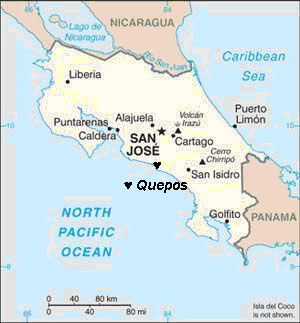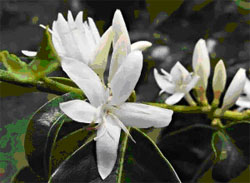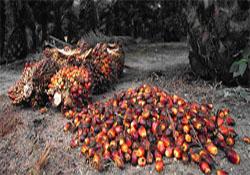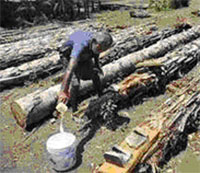|
|---|
Broken News
Miss Costa Rica Update
Last month we reported on the selection of 21 year old Nazareth Cascante Madrigal from Alejuela as the new Miss Costa Rica.
 |
|---|
Nazareth Cascante |
Now the press here are running articles that include a report by a major south and latin america radio and TV station called RPP out of Lima, Peru that Mz. Cascante is the leader in an extensive online poll being taken on who's the favorite candidate for Miss Universe.
By early June, Miss Cascante led the poll with over 154,000 votes. The next runner-up was Miss Guatemala with slightly over 79,000 votes.
Yes, OK, amigos this is a predominantly latino regional poll because of its source but the fact a babe from lil' ol' Costa Rica is pushing out all those other latin beauties is, in my mind significant. I can see why - take a look at that pic to the left. Also, the top ten in the RPP poll included ladies from Russia and other eastern European countries.
As of this writing, less than half of the total worldwide number of "delegates": (read contestants) have been chosen to attend the Miss Universe pageant to be held in December in a venue that had not yet been announced as of this publication..
Pura Vida, Naz, baby! Buena Suerte (Good Luck).
Jacó Stadium
What was that about accessibility to highway infrastructure spurring regional development?
Since the new Autopista (expressway) between San José and the Puntarenas area on the Pacific coast was opened about two years ago, the travel time to central Pacific towns and beaches has improved significantly. You can now jump in your car in the environs of the capitol and arrive in Jacó, a town about 40 miles north of Quepos, in a little over an hour.
 |
|---|
Artist's Rendering of New Jacó Football Stadium |
Although many cities and towns in Costa Rica were hit hard by the recession there are increasing signs of recovery, particularly in Jacó.
One of these was a new theater for the performing arts called Jacó Ocean Center and located on the main drag that runs parallel to the beach. Now word comes that a new football stadium will also be constructed in Jacó, a 7,000 seat arena costing about $5,000,000. That seating capacity is pretty close to the permanent population of Quepos/Manuel Antonio
They will break ground for the new stadium in September of this year and completion is expected early in 2014. It is planned to be finished in time for a scheduled FIFA U-17 Women’s World Cup game. In addition, the stadium will be home to the new Jacó Rays professional football team. The Rays were founded in 2010 and compete in a second-tier league that vies for the right of one team to join the first tier. Go rays.
Solo Bueno, Amigos!
If you happen to be one of the seven people in the Western Hemisphere that hasn't heard of the Mayan doomsday prophecy, let me quickly summarize.
 |
|---|
Reuben's Painting of the Apocalypse |
The Mayans, who were known to have existed mucho-B.C., but who reached their cultural height in the 250-900 A.D. period, were known to be excellent readers of the motions of stars and therefore eventually developed a very accurate calendar. Earlier interpretations of their artifacts revealed that the Mayans made calendar projections through to December 21, 2012 where the forecasts stopped abruptly. Over the years, the legend developed that the calendar ended there because the Mayans believed that was the date of the end of the world. NOT.
Now comes evidence that expecting the demise of the planet on December 21, 2012 might be a bit premature. When some archeologists recently entered a newly uncovered Mayan cave in Xultan, Guatemala they found a large display on the walls of brightly colored artwork dating to the 9th century. Other walls gave evidence as to how the Mayans charted the stars. In addition to the artwork there were many columns of numbers arrayed on the walls which eventually were deciphered by archeologists as relating to their calendar. It became evident that the room was part of the effort to chart the stars and calendarize the future.
The Maya had a 260 day ceremonial calendar and a 365 day solar calendar. The Maya combined those two calendars to make a longer cycle of time that repeated every 52 years, but they also kept track of the motions of Venus and the motions of Mars and perhaps the motions of Mercury. The only problem with the new finding is that the calendar discovered was projected 7,000 years into the future which means we may have another 4,800 years or so to go before we reach a valid apocalypse date, assuming they don't find more rooms and number arrays to change the final date again.
Gee GG, I hope this means we don't have to cancel all of the end-of-the-world parties planned for December; that would be a bummer.
¡Pura Vida!
Stats on Two States
(Big Guy vs Little Guy)
It's only natural that we ex-pat gringos, golden or otherwise, are interested in comparing our country of origin and our country of adoption, even if only adopted for retirement as is the case with our hero. Before I go on, let me state flatly here that I will forever, first and foremost be a U.S. American no matter on which beach I throw my towel.
 |
|---|
| Map of Costa Rica Showing the Relationship Among Cities and to Neighboring Countries |
Having said that, what follows is a demographic and quantitative comparison of the United States and Costa Rica. I put this together for the purpose of simply understanding the facts and not to make a qualitative comparison in any way (well, maybe the "Ease-of-Doing-Business Index" is a bit qualitative).
Firstly, let's remember we're talking about two countries of greatly different size in both area and population.
The U.S. has 75 times the land area of Costa Rica (size does matter in statistics) and has 68 times the population. Tico land is roughly the size of Louisiana and has approximately the same number of people as South Carolina.
Because of its jagged Pacific coast there are 780 miles of shoreline on the west side of Costa Rica versus a relatively straight 132 miles on the caribbean side, for a total shoreline of 912 miles. This means Costa Rica has about one half the shoreline of Florida, the sunshine state being totally surrounded by water except in the north..
Now to the stats. In order to keep things simple, the following table is expressed in English units and U.S. dollar currency values.
Population growth rate is slightly higher in Costa Rica than in the States (1.3 vs 1.1%). If both countries maintained these growth rates, the population of Costa Rica would roughly double to 9,000,000 in 54 years or by 2066 and the U.S. population would then be approximately 565,000,000 people. The ratio of the two countries populations would then drop from 68 to 61, not much difference.
| U.S./Costa Rica Demographic Comparison (Mostly 2011 Data) | |||
|---|---|---|---|
| Demographic | United States | Costa Rica | Ratio-US to CR |
| Area, Square Miles | 3,800,000 |
51,000 |
75:1 |
| Population | 312,781,000 |
4,579,000 |
68 |
| Pop Growth, %/Year | 1.1 |
1.3 |
0.85 |
| Median Age, Years | 36.7 |
26.5 |
1.3 |
Net Birth Rate (Births - Deaths) per 1,000 |
8.38 |
13.09 |
0.6 |
Life Expectancy, Yrs |
78.11 |
77.58 |
1.0 |
| Literacy, Able to Read and Write/Age 15, % | 99 |
94.9 |
1.0 |
| Illegal Immigrants, Est. % of Population | 3.7 - 3.8 |
10 - 22 |
0.23 |
| Source of Illegals | Latin America (Mostly Mexico) |
Primarily Nicaragua |
|
| Murder Rate, per 100,000 Population | 4.8 |
11 |
0.44 |
| Per Capita Income | $47,140 |
$6,580 |
7.2 |
| Inflation Rate, %, 2010 | 3.0 |
5.2 |
0.6 |
| World Bank Ease of Doing Business Index Rank, 2011 | 4 of 183 |
121 of 183 |
|
Note that literacy rates and life expectancy are virtually the same in both countries. The more interesting statistics are in the area of average age and in the net birth and death rates. I've had the impression for some time that the average population here was younger but I didn't know if it was just in the Quepos area or not. The statistics show the average age of a Gringo is ten years or almost 40% higher than the average age of a Tico. (Dude, I feel the pain) This is also reflected in the net birth rates (birth rate - death rate) because of a higher death rate in the U.S. due to the aging population.
Illegal immigrants are a problem in Costa Rica as well, and a bigger one at that. The % of illegal immigrants in the Costa Rican population (10-22%!) is primarily Nicaraguan. Many Nicas have crossed the border to try and participate in a much more vigorous economy. Some Ticos have the idea that the Nica influx is also the reason for increasing crime rates here but I could find no data that either corroborates or debunks this.
 |
|---|
The current murder rate in Costa Rica is twice that of the U.S. but still the lowest of the seven countries of Central America. The rate in Honduras, for example, is a full 8 times that of Costa Rica (86 versus 11 per 100,000) and, as a result, Honduras enjoys the dubious distinction of being the murder capital of the world. The statistic for Honduras' neighbor to the south, El Salvador, is almost as high at 71 per 100,000.
The per capital income stats are dramatically different in favor of the U.S. These figures do not attempt to adjust for cost of living which many assume to be less in Costa Rica, although sometimes I wonder about that, at least for the Quepos/Manuel Antonio area. Inflation in Costa Rica has historically been two to three times that of the U.S. but now is only about 60% higher, having dropped significantly during the recession.
Finally, I threw in an old favorite of mine, the World Bank Ease of Doing Business Index which the chronicles has written on before (Rank Ranking). The good but not outstanding news is that Costa Rica advanced four levels in this year's ranking to 121 from 125 last year. The U.S. advanced one, from 5 to 4. Any gringo who has started a corporation, run a business or even applied for a residency permit here understands what this unhappy rank means. (Singapore and Kong Kong rank one and two respectively, ahead of the U.S.)
Maybe next year, my Tico buddies, you could get this rank up to the median level (92)?
Coffee & Shrooms
(Java is Short, Shrooms Will Pop Up)
The biggest Costa Rican export product these days is microchips. They now account for a full 20% of all exports here.
Total Costa Rican exports in the first quarter of this year increased by 16% over 2011. U.S. Exports were up 8.2% in the same period but, of course, the U.S. volume was much larger. The manufacturing sector here, which is dominated by Intel, accounted for two-thirds of the national increase in exports.
 |
|---|
A Coffee Plant in Bloom |
While manufacturing was in the chips, the coffee industry this year has a problem of a different flavor (sorry, I'm a sucker for puns), i.e., a shortage of growing capacity. Tico coffee, based largely on Arabica beans (the name coming from the original plants that were cultivated in Arabia) and which are grown in the rich soil of the central Terrazu region has been declared to be among the best in the world by java experts and aficionados.
Large coffee marketers such as Starbuck's, Green Mountain, some European brands and others are placing ever greater demands on bean supply here, the kind that will take time for growers to adjust to. And now that there are reports saying coffee is a health food, there's no reason to believe exports here will do anything but grow.
Coffee plants begin to blossom with the first downpours of the rainy season. Plants blossom and fill the farms with a rich perfume. This year the rains have been early and substantial and the early-flowering coffee plants promise a record harvest yet demand still is expected to outstrip supply. Growers are so concerned about supply they are considering importing extra beans from Brazil, the number one world coffee producer to fill the gap. You could have worse problems amigos, like too much product and not enough customers.
For more on the history of coffee (and bananas) in Costa Rica go here: Choo Choo Chiquita
Now about mushrooms.
A new organization called the Cámara Costarricense de Productores y Exportadores de Hongos is trying to increase shroom production and make Costa Rica into a net exporter. The CCPyEdH aims to dramatically increase production of those little fungus devils that so many people like. The CCPyEdH descriptor translates as the Costa Rican Chamber of Producers and Exporters of Mushrooms. (Costa Ricans can sometimes get a little formal in their naming systems - why not the National Mushroom Association or NMA amigos? - of course in Costa Rican I suppose Tico protocol would have to have it as ICH or Instituto Costarricense de Hongos )
 |
|---|
Oyster Mushrooms Growing On a Tree |
My unscientific survey or observation, however, is that Ticos eat less mushrooms than the average earthling. You see mushrooms in restaurants and the supermarkets but they're just not used in cooking as much here as in the U.S. for example. That may have something to do with the fact that 45 tons are imported every month here and only 3 tons are produced every year.
That means Costa Rica is now producing only enough mushrooms to cover a few thousand pizzas. It also makes shrooms rather high priced compared to stuff grown here because of import distribution costs and duties.
Oyster mushrooms, common in the jungle and considered a delicacy here are reported to reduce cholesterol. So are other, wilder mushrooms that grow easily on trees and are enhanced by the wet, tropical climate. (Personally, I think the soil and climate here are so rich and favorable to farming that you could grow rocks if you wanted to)
There is a great deal of agricultural waste product here that is beneficial as fertilizer for growing mushrooms. Even sawdust and coffee have been used by some Costa Rican farmers to raise mushrooms and, of course, like many places in the world, the growing soils are enriched by stereotypical forms of animal caca.
Best wishes amigos that your shroom industry mushrooms.
Of Palms and Pods
(Oil About Those Strange Palm Clusters)
If you live in the South Central pacific coast of Costa Rica, like GG, you can't help but notice the thousands of acres of palm tree farms along the coastal highway as well as the trucks and oxcarts hauling piles of strange looking, oversized pine-cone like clusters.
Worker Picking a Pod From a Non-Hybrid African Palm Tree |
 |
Palm Oil Pods and Nuts ("Oil Dates") |
A Couple of Tico Dudes With Oxen and Cart Full of Palm Pods |
How these farms came about was described in an earlier Chronicles article about the rise and growth of banana farming here. Many of the thousands of acres of palm oil nut farms seen along the coast were first planted in the 1940's after a blight devastated the banana plantations which the palm trees now occupy. African palms are much more disease resistant than banana plants and the processed palm oil product is much easier to handle and distribute than is a delicate fruit like bananas.
Ironically, as the banana industry declined around Quepos, the port activity did also. The once important banana port declined because palm oil can be easily shipped overland in truck and rail tankers rather than by water like the bananas were. Only recently has the local port recovered and then only because of a significant new marina which caters to private pleasure craft.
Each African palm tree produces large pine-cone shaped clusters or "pods" (picture left) the fruit or nuts of which can be processed into an oil used in a variety of products ranging from hand lotions to cooking oils. A new hybrid of the African palm is now being favored because it is much shorter than the old non-hybrid tree. It can be more easily picked, for example, from the back of a pickup truck without resorting to long and awkward extension cutters (photo left).
The individual nuts are also called "oil dates". When they turn red or orange, the pods are ready for harvesting. Occasionally, one might hear the clusters referred to as "coyol" but the person using that term is likely to be a Guancasteco (someone from Guanacaste - see What's-In-A-Word below) as that term is used more commonly to describe a particular palm tree prevalent in Guanacaste.
When a pod is cut and drops to the ground, individual dates may break away from the cluster. When harvesting the dates, it's not uncommon for a small group, usually women and children, to follow the pickers and gather the stray dates. The pods are usually stacked in trucks and sometimes, like in the old days, they are loaded onto old fashioned carts complete with oxen. The pods are hauled off to the local processing plant for rendering. Our local plant (Palma Tica Corp.) is situated a few miles north of Quepos on the main highway.
Here are the main steps in processing oil dates:
1. The FFB's (the pods are also called Fresh Fruit Bunches or FFB's) are processed in a rotating steam pressurized tank that removes the fruit from the stalks and sterilizes them.
2. The stalks can be sent back to the plantation as mulch and any excess is burned as boiler fuel (I guess that's the black smoke you see coming out of the plant periodically). The ash from the combustion is rich in potassium and can be recycled as potash fertilizer for the palms.
3. The fruit proceeds to a digester tank where the pericarps (shells) are separated from the nut cores by agitation.
4. The shelled fruit kernels are sent to a continuous screw press where oil and water are pressed out of the fruit, leaving a mash or press cake. This last biomass can be recycled as mulch or incinerated like the stalks.
5. The oil/water mixture is filtered and sent to settling tanks to allow gravity to separate the oil from the water. A typical plant produces 0.65 tons of raw palm oil per ton of FFB's (that's what the literature says but our hero is a bit skeptical - this yield seems high to an old frizzled chemical engineer for this kind of process.
 |
|---|
Some Products Containing Palm Oil |
If you really want to get into the details on palm oil processing, go here: Palm Oil Extraction & Processing.
World production of palm oil in 2012 is expected to be about 53,000,000 metric tons (!). Yeah, that's right, about 117 billion pounds and that's over six times 2011 U.S. Steel production.
Although it seems like Costa Rica, particularly in this region, is a major producer of Palm oil, in actuality Costa Rican annual output is only about 0.4% of world production or 250,000 metric tons. Indonesia, Malaysia and Thailand account for over 90% of total world production
Now about the uses of palm oil. I fully expected to learn that palm oil is used in lotions, soaps, creams and the like but I didn't realize until now that it can also be found in many food products.
As many as one in ten products found in a supermarket contains palm oil. You can cook directly with palm oil and you can enhance the consistency of various edible products with it (see sample product list right).
I expected to find brands like Dove and Palmolive Soaps, Jergens Lotion, Johnson Baby Shampoo and a variety of tanning lotions among the list, which I did, but I was surprised by other brands like Ben & Jerry's, Colgate Toothpaste (my personal brand choice), Clover Margarine (gimme butter), Ritz Crackers and various brands of chocolate bars? Yup, they all use palm oil.
Some of the products even have the word "organic" on them, for which of course, the African Palm and the processing described above would qualify, being grown without synthetic fertilizers or enhanced with other chemicals. On the other hand, like many things these days, there is an environmental controversy on use of land for palm oil production which I won't get into here.
(Many thanks to contributing editor Don Voelker of Heredia, Costa Rica for his input to this article and particularly for the photos of oil date farming above and the paintings used in the Chronicles header at the top. To see more of Don's art work, go here: www.donaldopaintings.com)
What's-in-a-Word
Veranilla de San Juan
The rainy season usually starts in May and the average temperature drops a few degrees. Then, around the summer solstice, or June 21, there is a brief reversal to summer conditions, sometimes even hotter that the regular season. It happened this year but it seemed like it started earlier in June and ran longer than usual.
The word for summer in Spanish is verano; therefore "veranilla" is a "little summer". The Ticos and Latinos in general love to diminutivize (is that really a word GG?) nouns using suffixes such as ..llo, ..lla, ..ito or ..ita. Chiquillo or chiquito therefore are diminutives of chico or boy and chiquilla or chiquita are diminutives for girl, both genders changing the middle "c" to "qu" to ensure the correct sound.
I had heard several theories as to why this phenomenon is called Veranilla de San Juan. All agreed that the saint being referred to was St. John the Baptist. Some said the term is an allegorical reference to the short difference in time that occurred between the careers of Saint John the Baptist and Christ, while others said the name was first used in the province of San Juan, Argentina where the aforementioned weather condition is prevalent. The real answer came from my Spanish teacher, a former religious. "It's called that because the summer solstice, June 21, happens to be the feast day of San Juan Baptista". Gracias, maestro.
A little more colorful terminology than Indian Summer, don't ya think?
The term "coyol" was mentioned above in relation to the oil date clusters of the African Palm. But the origin of this term is from another palm, the Coyol Palm, and is also the name of a drink derived from the Coyol tree.
 |
|---|
Worker Extracting Coyol from a Palm Trunk |
 |
Guanacaste Artist's Painting of a Man Who's Had Too Mucho Coyol (Hic) |
Coyol palms are prevalent across much of latin america including the Pampas of Argentina, Nicaragua and even Mexico. They also are prevalent in the northern Guanacaste province of Costa Rica, which is often mentioned as having the same topography as Nicaragua. In addition there is a town off the autopista between the coast and San José that is actually named Coyol.
The drink referred to is made from the sap of a felled coyol palm. The sap is fermented in the sun (see photo left) and the process yields a cloudy, frothy, pale yellow liquid referred to as "vino de coyol". Indigenous people of Mexico and other countries have been drinking this stuff for thousands of years. The drink is reported to be moderately alcoholic (hic) and is often the center of fiestas in peasant areas. It's not uncommon to find it for sale at roadside stands packaged in re-used plastic bottles that were originally occupied by other drinks like water and soda.
Reportedly vino de coyol has a rather unique property. (Our hero doesn't sample alcoholic beverages anymore, otherwise I'd give you my personal taste-test results). Apparently, after drinking coyol, the process of inebriation occurs not only by the alcohol in the liquid but by some type of enzymatic reaction of the liquid in the body that occurs if the drinker is exposed to bright sun.
This means that one can drink coyol, get high in the sun for awhile, then sleep in the dark and resume the inebriation process the next morning just by going out into the sun again. Two drunks for the price of one - what a deal! (I wonder if there are also two hangovers?)
Being around so long, and being such a center of celebration, there had to be a song written about coyol sooner or later. There is and here's an excerpt:
 |
|---|
"Bibeindo coyol, bibiendo coyol, paso la mejenga..." (Drinking coyol, drinking coyol and watching the local football game...)
:Life is good on the pampas.
ROMEO Corner
(Retired Old Men Eating Out)
La Cubanita
Note: This restaurant has closed since at least January 2015Location: On the street that connects Paseo Colon de Quepos with Avenida Central (MAP),
50 meters north of the Quepos football field.
Hours: Lunch and Dinner, Pretty Much Every Day
Parking: Plentiful in front of or near the restaurant - this is not a busy side street.
Contact: Telephone: Not sure why you'd want to call - just walk in, this isn't the Ritz.
Reviewing ROMEOS: Hal H., Gypsy M., Bob N.
To Review Our Rating System and Procedure, go here: R.O.M.E.O. Rating System
This is one of the simple restaurants with good food located in Quepos centro. La Cubanita (little Cuban lady) refers to the owner, a lady who suffered the exodus from Cuba in the 1960's and settled in Tampa for a number of years before migrating to Costa Rica.
The dining room will not win any awards in Architectural Digest but it is a well lit and homey room. We chuckled over our table on this last visit as it was at least six inches higher than standard. It was covered with a transparent plastic tablecloth but I did notice that underneath the plastic was an intricately crocheted lace tablecloth like my grandmother use to make. Neat. For overall atmosphere we give the restaurant two sloths. The food is basic latino but with a Cuban flare. For starters we shared a common plate of patacones, or sliced and deep fried plantains, served with a cup of refried beans topped with cheese that could be spread on the patacones. Yummy. For a main course GG chose arroz cantonese or rice mixed with small pieces of pork, beef and shrimp. It was served with very crispy fried yucca, the best fried yucca I've had in this area. |
 |
|---|---|
$$ |
Another ROMEO had a bowl of spaghetti with pieces of chicken in La Cubanita's special sauce, a light tomato concoction with an unusual and mild flavor unlike Italian but excellent in it's own right. A third ROMEO had a casado with a piece of chicken filet with salad and other accompaniments.
Service was basic but courteous and pleasant. For ambiance, food quality and service we give La Cubanita an overall rating of three and a half sloths,
For a full meal, La Cubanita is as inexpensive as it gets in this area, For the appetizer, the three plates of main courses and several sodas, the total bill came to around 15,000 colones or $30. That means a two-dollar rating in our lexicon.
Three and a half sloths combined with a two-dollar price rating means high value. So for a simple, tasty and economical Tico/Cuban home style meal, try La Cubanita.
Founder's Quotes
"There are more instances of the abridgment of the freedom of the people by gradual and silent encroachments of those in power than by violent and sudden usurpations." -- James Madison, speech at the Virginia Ratifying Convention, 1788
don Beto de Quepos, El Gringo Dorado Pura Vida! |
Be pithy but kind. I'm sensitive. |
|---|








